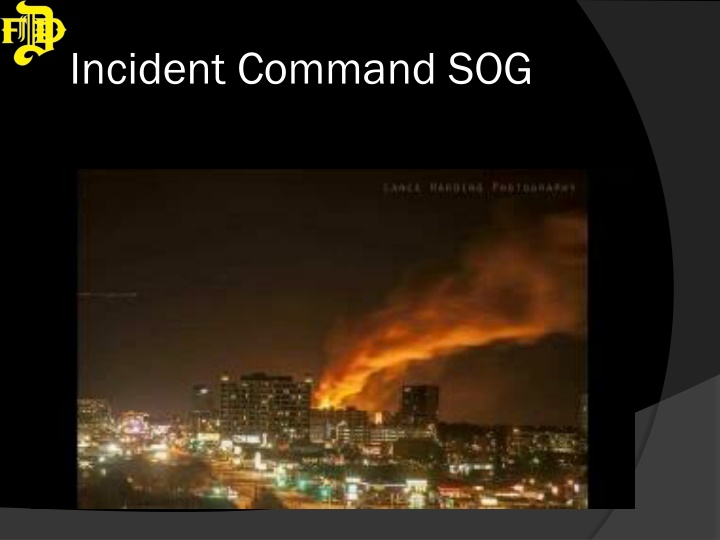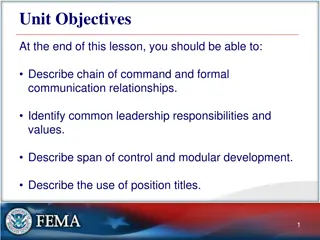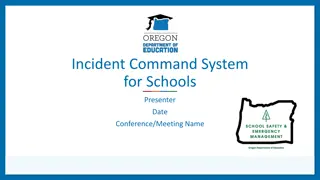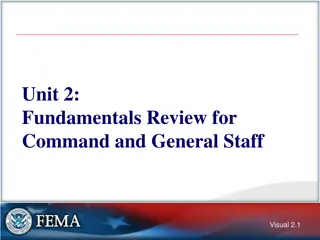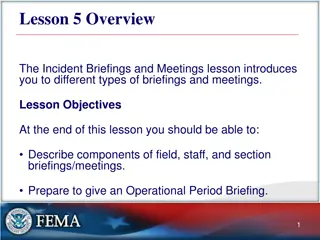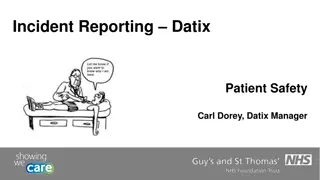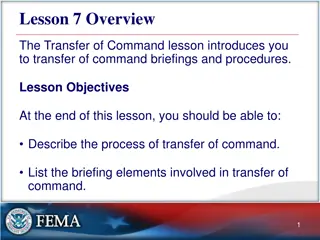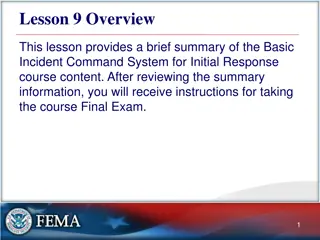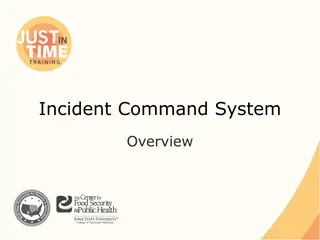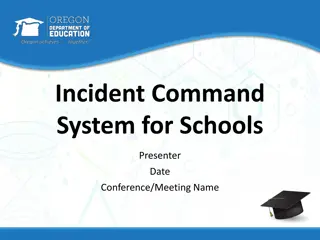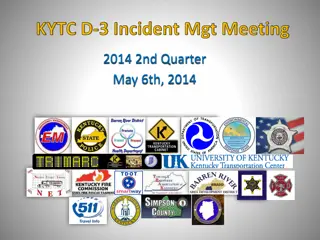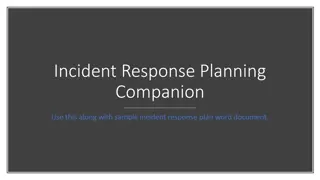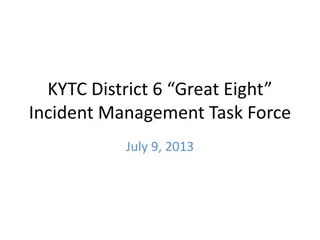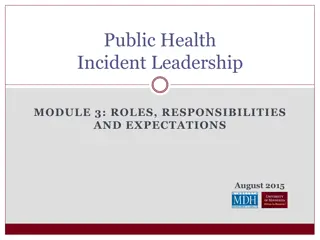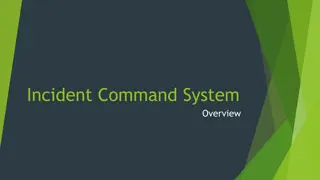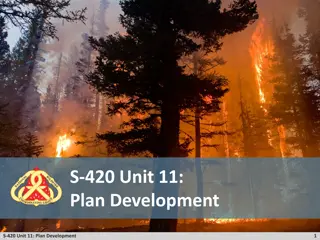Incident Command Structure and Span of Control Overview
Incident Command Structure helps in managing incidents effectively by utilizing ICS terminology and levels as needed. The flexibility within ICS allows for structuring incidents correctly based on individual needs. Understanding the Span of Control is crucial for supervisors to manage the number of individuals effectively. Factors affecting the Span of Control include experience levels, complexity of the incident, size, and type. By following the recommended Span of Control for Single Resources, implementing higher ICS levels may not always be necessary. Only add components that are essential to your command structure to streamline incident management efficiently.
Download Presentation

Please find below an Image/Link to download the presentation.
The content on the website is provided AS IS for your information and personal use only. It may not be sold, licensed, or shared on other websites without obtaining consent from the author.If you encounter any issues during the download, it is possible that the publisher has removed the file from their server.
You are allowed to download the files provided on this website for personal or commercial use, subject to the condition that they are used lawfully. All files are the property of their respective owners.
The content on the website is provided AS IS for your information and personal use only. It may not be sold, licensed, or shared on other websites without obtaining consent from the author.
E N D
Presentation Transcript
Incident Command SOG ICS SOG focused on the most common ICS terminology and levels used on the DFD ICS flexibility-many ways to structure an incident correctly within the ICS framework Due to the variability of each incident, unwise to prescript organizational structure (exception on the DFD is Tech Incidents) Build ICS to fit the incident, not make the incident fit ICS
Incident Command SOG The vast majority of incidents on the DFD do not progress beyond the Single Resource level Next most frequently used level is Groups/Divisions Higher levels above Groups/Divisions rarely used on DFD but everyone should be familiar with them. This PowerPoint focuses on Single resources/Groups/Divisions Refer to SOG for info on Branch level and above
Incident Command SOG Span of Control- number of individuals that a supervisor is responsible for, expressed as the ratio of supervisors to individuals Ideal Span of Control varies between 1:3 to 1:7 Complex incidents may require a Span of Control on the lower end of the range Experienced IC may be comfortable with a Span of Control on the higher end of the range
Incident Command SOG Factors that affect span of control Experience level of supervisor/ IC Experience level of subordinates Complexity of incident Size Type Rapid growth vs stabilizing quickly
Incident Command SOG As long as a supervisor is within the suggested Span of Control of Single Resources, higher ICS levels do not necessarily need to be implemented Only use/add what you need in your command structure
Incident Command SOG Single Resources An individual, piece of equipment with personnel, or a crew or team with a supervisor (Examples: Chief 2, Rescue 1, Engine 22) Lowest level of ICS
Incident Command SOG Example of a fire that can be handled with only Single Resources
Incident Command SOG In the previous slide, this fire would need 1 Engine with an Attack Line, 1 Engine with a Back Up Line, 1 Truck to Search, 1 Truck to the roof, 1 RIT, and all other Companies standing by for a Span of Control for the IC of 1:5. No Groups/Divisions needed.
Incident Command SOG Groups/Divisions Next level used by DFD in ICS above Single Resources Groups-responsible for completing a task Example- Search Group for conducting a search of a structure Example- Fire Attack Group for extinguishing a fire Divisions- responsible for an area Example- Division 5 for completing all tasks ( search, rescue, extinguishment) on the 5thfloor of a structure Person in charge of Groups/Divisions is a Supervisor Groups/Divisions are the same management level, one is not subordinate to the other Horizontally challenged incidents-lean towards using Groups Vertically challenged incidents-lean towards using Divisions
Incident Command SOG When creating groups/divisions let everyone know Name of the Group/Division Who is in the Division/Group Responsibilities of the Group/Division Designation of the Supervisor
Incident Command SOG Example 1: Truck 12 officer, I am creating a Search Group, you will be my Search Group Supervisor, your crew (T12), T04, and Rescue will be in your Group, your Group will be searching this structure. Example 2: Chief 4, I am creating Division 2, you will be my Division 2 Supervisor. E15,E08,TR15, and T08 will be in your Division. You will be completing all tasks on the 2ndfloor (extinguishment, search, rescue, etc.)
Incident Command SOG Apartment Fire Example (Divisions)
Incident Command SOG In the previous slide, this fire would beyond the IC s Span of Control using only Single Resources. This fire is a good candidate for Divisions. Division 3 for all tasks on the 3rdfloor, Roof Division for vertical ventiliation, Division 2 to evacuate the 2ndfloor and also to check for extension from the fire above. A Single Resource (one Company) to evacuate the 1stfloor if needed.
Incident Command SOG Apartment Fire Example (cont d) Each Division could have up to 7 Single Resources(Companies) in it if needed. Total of 21 Companies with a Span of Control for each Division Supervisor of 1:7 and a Span of Control of 1:3 for the IC. In this example, if each Division was maxed out, plus having one Company on the 1stfloor and a RIT, the IC s Span of Control would be 1:5 and the Incident would be at a 4 Alarm Level.
Incident Command Warehouse Fire Example(Groups/Divisions)
Incident Command In the previous slide, this fire would beyond the IC s Span of Control using only Single Resources. This fire is a good candidate for a mix of Divisions and Groups. A Fire Attack Group with the task of extinguishing the fire. A Search Group with the task of searching the entire warehouse. A Horizontal Vent Group to open all bay doors A Roof Division to evaluate the roof, vent if needed (open skylights or create openings) By using Groups/Divisions at this fire, the IC could potentially use up to 28 Companies and still be within a comfortable Span of Control
Incident Command If any of the previous examples progressed into a Defensive fire, the IC could evacuate the structure, do a PAR of each Group/Division, disband those Group/Divisions, and then easily create exterior Divisions based on the sides of the building (Alpha Division, Bravo Division, Charlie Division, Delta Division).
Incident Command SOG During an incident, as the staffing needs of Groups/Divisions change, the IC can remove/add/reassign Companies as needed, changes will be based upon updates and information obtained from Group/Division Supervisors
Incident Command SOG The majority of incidents that Denver Fire responds to can be handled by using a very simple command structure (Incident Commander and Single Resources). Larger incidents (example - multiple alarm fires) necessitate the use of Divisions/Groups. All personnel should have a working knowledge of these simpler management levels.
Incident Command SOG Commonly used Command Staff Safety Officer: Every group response and technical rescue in Denver has a Safety Officer (Ops-2) assigned automatically. PIO: At any incident, the Incident Commander can assign a PIO (Public Information Officer) to assist with interactions with the media and public. Command Staff are not considered as part of the IC s Span of Control due to their ability to work autonomously.
Incident Command SOG Branches and Above There is a huge potential for extremely large and complex incidents to occur in Denver, these incidents could require complex Incident Command structures. The focus of this PowerPoint is only basic levels of ICS, please refer to the DFD Incident Command SOG for information regarding management levels above that of Groups/Divisions.
Incident Command SOG Summary Denver Fire now has an Incident Command SOG to utilize in order for all personnel to understand ICS terminology and management levels that are most commonly used.
